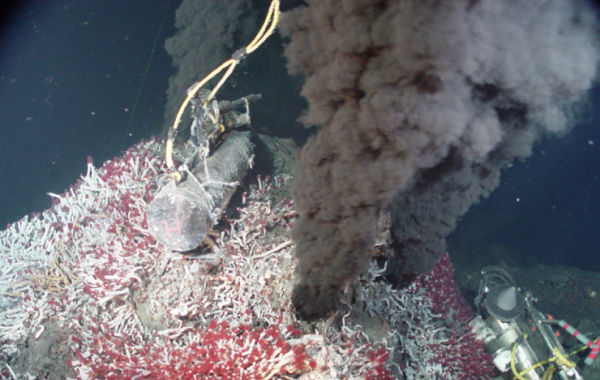Oceanic Phosphorous Lends Light to the Hunt for Habitable Worlds

When it comes to chemical elements needed for life to begin anywhere — whether on the early Earth, or any number of rocky planets elsewhere in the universe that may be promising venues for life — the focus is usually on oxygen, carbon, and nitrogen. Chris Reinhard, associate professor in the School of Earth and Atmospheric Sciences, offers a helpful reminder: don’t forget about phosphorus.
“It’s central to biochemistry for all life on Earth. It’s an important component of nucleic acids and energy transduction in cells,” says Reinhard, referring to other necessary building blocks for life. “When you’re thinking about the kind of ingredients used to build life from non-life, it’s one of the key components in that mix.”
Reinhard is part of a research team that may have a new theory about the phosphorus cycle in that mix, and where much more of the nutrient could be found. That could also give scientists a better chance to detect signs of life on other worlds that they might have previously scratched off their “potential for life” list.
Their study “Nutrient Supply to Planetary Biospheres from Anoxic Weathering of Mafic Ocean Crust” is published in Geophysical Research Letters. (Mafic refers to the types of dark-colored rocks found in the crust, such as basalt.) Reinhard is co-lead author of the study along with a postdoctoral researcher, Drew (D.D.) Syverson of Yale University.
Right now, scientists believe continents above sea level are required for habitable planets to support a robust biosphere, because that essential phosphorus nutrient cycle starts on land, and ends up in the ocean. “We use experimental geochemistry and a simple model of biological cycling to show that this is incorrect,” Reinhard says, “which significantly expands the possible range of planets that may host surface biospheres that would be detectable through telescope observations.”
Speed limits, sinks, and “smokers”
The largest source of phosphorus on Earth is found in rocks in its crust. On exposed continents above sea level, that rock-derived phosphorus becomes available to the marine biosphere via continental weathering — the steady bombardment of environmental conditions like rain, extreme temperatures, and biological activity — that eventually leaches that phosphorus into the ocean via soils, rivers, and streams.
Phosphorus in nature is also in short supply, and that makes it a limiting nutrient, acting as a brake on growth in the biosphere. “It’s one of the reasons we’re interested in phosphorus,” Reinhard says. “Life also needs carbon and nitrogen and various trace elements, but it’s phosphorus that really kind of sets the speed limits on the biosphere — the extent to which it can do what it does on a global scale.”
Phosphorus is also found coming from hydrothermal vents on ocean floors, systems similar to the famous “black smokers” where seawater is heated to ultra-hot temperatures by liquid rock deep below the Earth and shot out through the seafloor. “When this happens, all kinds of interesting chemical reactions are going on,” Reinhard says. “This is potentially a conduit for unlocking the phosphorus into the biosphere.”
The problem, however, is that those vents also release a lot of iron at the same time. “What happens when you pump this super-hot sea water, with these dissolved goodies in it, into the bottom of an ocean that has a ton of oxygen in it, the way the modern earth does? You essentially rust that iron,” Reinhard explains. “One thing that rust is good at is scavenging and removing dissolved phosphate from solution. So these vents are actually stealing food from Earth’s biosphere on the whole.”
The consensus is that those hot seafloor vents act as phosphorus sinks, but Reinhard and his team may have found that just the opposite can happen under certain conditions. “It’s thought that hydrothermal systems will remove phosphorus from the phosphorus cycle. That’s why they’re referred to as sinks,” he says. “Our results turn that on its head. In many respects, what we’re suggesting is hydrothermal systems in many cases can be quite large potential sources of phosphorus instead of sinks.”
Oxic vs. anoxic
It all depends on whether that hydrothermal alteration of the seafloor is happening under oxic (oxygenated) or anoxic (oxygen-free) conditions.
If anoxic, that phosphorus could potentially be harvested, Reinhard says.
“We did some experimental work looking at the chemical reactions between ocean crust and anoxic (oxygen-free) seawater, and ended up finding a novel route towards the production of nutrient phosphorus,” Reinhard says.
The team did that by taking pieces of that ocean crust and incubating them at temperatures and pressures meant to mimic how that crust is changed by hydrothermal activity. “We used a novel isotope tracer method to track the degree that crust was being dissolved, and the rate materials were being released into solution,” says Reinhard.
The research team estimated the ratio between phosphorus release and carbon dioxide consumption in their findings. As stated in the study’s abstract, “This ratio is comparable to that of modern rivers, suggesting that submarine weathering under anoxic conditions is potentially a significant source of bioavailable phosphorus to planetary oceans.”
The team’s findings also mean that ocean-covered planets and moons could join rocky planetary bodies as potential targets for the next generation of orbiting telescopes and planetary probes looking for key elements and molecules like phosphorus, oxygen, and methane as clues to habitability.
According to the study, “Volatile-rich Earth-like planets lacking exposed continents could develop robust biospheres capable of sustaining remotely detectable atmospheric biosignatures.”
Reinhard adds: “We think this result is likely to reshape the way folks look at the evolution of nutrient cycling on Earth, how the capacity of the biosphere to produce oxygen has evolved over time, and the likelihood that life will be remotely detectable on other rocky planets.”
Funding for this research was provided by NASA's Interdisciplinary Consortia for Astrobiology Research (ICAR) and the NASA Nexus for Exoplanet System Science (NExSS).
Citation: https://doi.org/10.1029/2021GL094442


